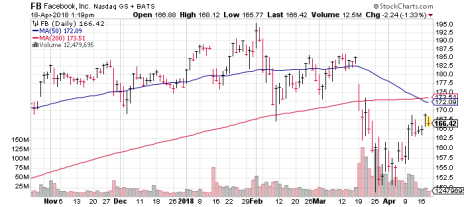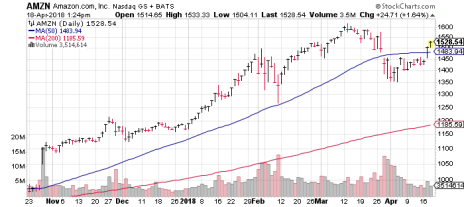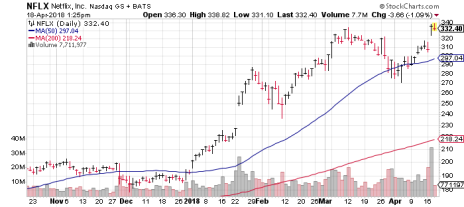The FAANG stocks – Facebook (FB), Amazon (AMZN), Apple (AAPL), Netflix (NFLX) and Google (GOOGL) - have been the five horsemen of the Nasdaq’s advance for much of the past few years. And for good reason! These stocks not only dominate their industries but have generally sported some of the best growth (and expected growth) prospects in the entire market, making them a magnet for institutional buying.
However, as time has gone on, the fundamentals and charts of these popular names have diverged. Thus, today, with the market attempting to bottom out, I’m going to review each one of these five FAANG stocks, sharing my honest thoughts on whether any are in a position to lead the next upturn. We’ll take them in order:
FAANG Stock #1: Facebook (FB)
Earnings Date: April 25 after the close
Expected EPS Growth: 18% this year, 21% next
After nearly five years of holding and making big money, I decided to sell FB from Cabot Growth Investor a few weeks back when the stock cracked its long-term 200-day moving average. But it wasn’t just that selloff that worried me—the stock had been stalling out for months even in a strong bull market, and it’s hard not to notice the OK-not-great earnings estimates as a sign that growth could decelerate going forward.
My biggest thought concerning FB, though, isn’t that the stock is going to fall 50% or anything dramatic. Instead, I think it’s becoming more obvious that the stock simply isn’t a market leader anymore—a look at the long-term relative performance line (it’s been a market performer since the Presidential election) and the massive volume break of the 40-week moving average is a sign that, after years of accumulation, big investors are paring back.
What about CEO Mark Zuckerberg’s Congressional testimony last week? Honestly, I don’t think it matters much. What counts more in the months ahead is the company’s growth outlook, which has slipped.
All that said, I’m willing to keep an open mind, and if FB can soar on earnings next week, maybe this will prove to be one big shakeout. But looking at the evidence today, it doesn’t appear FB will be a leader of the next rally. I’m looking elsewhere.
FAANG Stock #2: Apple (AAPL)
Earnings Date: May 1 after the close
Expected EPS Growth: 24% this year, 15% next
For the past couple of years, I really haven’t been a big fan of AAPL—sales, after all, have shrunk on balance over the past two years, while earnings were flat. For a growth investor, that doesn’t cut it, and when subscribers asked me for my opinion on the stock, I answered honestly that I really didn’t follow the company at all!
Today, though, I’m a little intrigued—thanks to a few factors: the iPhone X, revenue growth has been accelerating (up 7%, 12% and 13% over the past three quarters) and earnings are picking up steam (up 18%, 24% and 16% during the same time). And, as written above, analysts are optimistic, looking for a 24% earnings gain this fiscal year and another 15% pop next year.
As for the stock, its RP line is pretty flat going back to May 2017, so it’s not outperforming the market. That means I can’t get too excited. But AAPL is also just 4% off the highs of an 11-month base-on-base pattern, so an earnings-induced breakout above 182 would be intriguing for conservative growth investors.
Big picture, though, I still think AAPL is too big to be much of a mover—it has $239 billion in sales (!) and is highly dependent on new product launches and the “regular” upgrade cycles of its current lineup. Intermediate-term, though, a decisive earnings gap could easily lead to a sustained run.
FAANG Stock #3: Amazon (AMZN)
Earnings Date: April 26 after the close
Expected EPS Growth: 83% this year, 85% next
Amazon and Netflix have the two best growth stories and numbers, so it’s not surprising that both stocks have been doing the best in recent months. I, like everyone else, buy from Amazon all the time, think the company has a bright future and think the stock could still have more gas in the tank.
However, there are a couple of flies in the ointment. First, the stock enjoyed a huge moonshot earlier this year, rising 37% from the end of 2017 to mid-March (!), and that came after a big gap up on earnings in October. Thus, the stock could simply need more time to rest.
Backing up that thought is the stock’s big-volume break of its 50-day line three weeks ago and inability to get back above that line during its latest bounce, both signs that the stock is undergoing a well-deserved base-building effort.
Still, over time, I’d say Amazon is my second favorite of the FAANG bunch. My guess is it has higher highs ahead, even if it does need more time to consolidate its recent big move.
FAANG Stock #4: Netflix (NFLX)
Earnings Date: April 16—already reported
Expected EPS Growth: 118% this year, 58% next
NFLX is my overall favorite of the group, as it has the best combination of story, numbers and (following its earnings reaction) chart. As you can see in the chart, the post-earnings move brought the stock back to its early-March peak—it’s now in a six-week cup-shaped base.
Moreover, I like that NFLX basically took the second half of 2017 off; it made no net progress from mid-July through year end, so while it’s had a great run since the calendar flipped, at least it wore out some weak hands for a few months.
And, fundamentally, it’s easy to see how growth can continue internationally and, with management at least attempting to keep expenses in check, earnings are flying higher and easily topping expectations. I’m not opposed to nibbling on NFLX right here, though I’d prefer to see a modest pullback in the days ahead and a confirmed uptrend in the overall market.
FAANG Stock #5: Alphabet (GOOGL)
Earnings Date: April 23 after the close
Expected EPS Growth: 15% this year, 17% next
After AMZN and NFLX, I would probably place GOOGL next on my list of highest-potential FAANG stocks. The company has a tremendous history of growth, and surprisingly, that growth isn’t slowing down in a major way—revenue growth has averaged 23% during the past four quarters, with earnings up an average of 29%. What’s wrong with that?
The trick here is that (a) earnings growth is expected to slow, likely due to the company’s massive investments in new technologies, (b) the stock has been a market performer going on two years now, and (c) shares came under a ton of high-volume selling during the market’s March selloff.
That said, while it’s not the young buck it was a few years ago, I think GOOGL can do well. It might need more time to consolidate (you can say that about most stock, and even the entire market) but I haven’t seen any definitive signs that the stock’s long-term uptrend has petered out.
Clearly, earnings season will have a big say on most of these FAANG stocks, but looking at the fundamentals and longer-term chart, I am most high on NFLX and AMZN, think GOOGL and AAPL could have runs if things go well, but barring a huge earnings gap, think FB has issues. Just my take, of course!
The New Market Leaders
What I’m really focused on, though, are the potential leaders of the next advance. And what I’m noticing is that most of the stocks that are set up to lead if the market confirms a new uptrend (which it has yet to do) are NOT household names.
This isn’t unusual—in fact, it’s probably healthy for the market as fresher leadership names take the baton from older, slower-growing, well-known names. This shift is also backed up by the strength seen in small-cap indexes relative to the Nasdaq and S&P 500.
One area I like is retail, and one of my favorite names I don’t own is Floor & Décor (FND), which has a cookie-cutter story that’s easy to enthuse about. Here’s what I wrote about the company in Cabot Top Ten Trader three weeks ago:
“Floor & Decor is probably the best cookie-cutter story that few investors have heard of. The company looks like a category killer in the flooring business—the firm’s 83 warehouse-style stores offer much more square footage (70,000 square feet on average), product selection and lower prices than the competition (more than three times as many flooring products as Home Depot, for instance, and management says its stores that are located near competitors do better than average as customers comparison shop), which have made them increasingly attractive?to both individual and professional buyers. The growth potential is enormous, both in terms of the store count (management expects 20% annual store growth for many years, with a long-term goal of 400 locations!) and in terms of boosting comparable store sales— that key metric was up a whopping 16.6% last year and 24% in the fourth quarter (!). There’s likely more where that came from given that professionals (who account for 60% of the company’s revenue) only give Floor & Decor 10% of their overall flooring spend. It’s a simple concept that’s produced excellent growth for years—sales regularly grow north of 25% (including a 40% boom in Q4), with earnings advancing faster than that, and management’s initial outlook for 2018 is for sales to grow 23% and earnings to advance 33%. The valuation (51 times estimated earnings) is big, but so is the long-term potential. We like it.”
The stock broke free from a base-on-base formation earlier this month on excellent volume and has held those gains since. A retreat of a couple of points (to the 52 to 53 area) would offer a better entry point, but overall, I think FND has what it takes to be a leader of the next sustained market rally.

Learn More

Learn More

Learn More

Learn More






